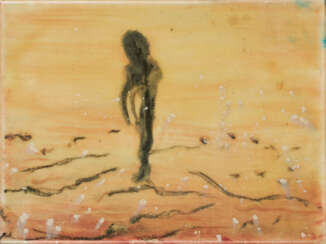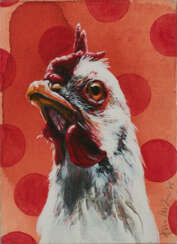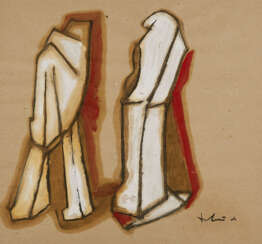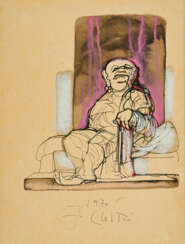
Galerie Michael Schultz - Part III

Peter Ackermann was a German painter and graphic artist. He became known for his alienation of architectural subjects. Ackermann was a representative of fantastic realism. The preferred subject of his work was classical Italian architecture, which he drew on site. He put together columns, portals and walls with machine parts, ruins and desolate parts of the city, which were piled up threateningly and thus alienated. In his etchings he showed references to the techniques of the old masters, his pictorial conception is compared with that of Giovanni Battista Piranesi and Canaletto.

Luis M. Alonzo-Barkigia is a contemporary Mexican artist. He studied at the Malmö Academy of Art (Sweden) and at the University of Illinois at Chicago. He was awarded the UIC Presidential Fellowship, the Larsen Fellowship for Studio Arts.

Andreas Amrhein is a contemporary german artist. His first verified exhibition was Arbeiten auf Papier „Blau“ at Galerie Michael Schultz in Berlin in 1994. Andreas Amrhein is most frequently exhibited in Germany, but also had exhibitions in Austria, China and elsewhere.

Andreas Amrhein is a contemporary german artist. His first verified exhibition was Arbeiten auf Papier „Blau“ at Galerie Michael Schultz in Berlin in 1994. Andreas Amrhein is most frequently exhibited in Germany, but also had exhibitions in Austria, China and elsewhere.

Andreas Amrhein is a contemporary german artist. His first verified exhibition was Arbeiten auf Papier „Blau“ at Galerie Michael Schultz in Berlin in 1994. Andreas Amrhein is most frequently exhibited in Germany, but also had exhibitions in Austria, China and elsewhere.

Andreas Amrhein is a contemporary german artist. His first verified exhibition was Arbeiten auf Papier „Blau“ at Galerie Michael Schultz in Berlin in 1994. Andreas Amrhein is most frequently exhibited in Germany, but also had exhibitions in Austria, China and elsewhere.

Andreas Amrhein is a contemporary german artist. His first verified exhibition was Arbeiten auf Papier „Blau“ at Galerie Michael Schultz in Berlin in 1994. Andreas Amrhein is most frequently exhibited in Germany, but also had exhibitions in Austria, China and elsewhere.

Andreas Amrhein is a contemporary german artist. His first verified exhibition was Arbeiten auf Papier „Blau“ at Galerie Michael Schultz in Berlin in 1994. Andreas Amrhein is most frequently exhibited in Germany, but also had exhibitions in Austria, China and elsewhere.

Andreas Amrhein is a contemporary german artist. His first verified exhibition was Arbeiten auf Papier „Blau“ at Galerie Michael Schultz in Berlin in 1994. Andreas Amrhein is most frequently exhibited in Germany, but also had exhibitions in Austria, China and elsewhere.

Georg Baselitz is a German painter, sculptor and graphic artist. In the 1960s he became well known for his figurative, expressive paintings. In 1969 he began painting his subjects upside down in an effort to overcome the representational, content-driven character of his earlier work and stress the artifice of painting. Drawing from myriad influences, including art of Soviet era illustration art, the Mannerist period and African sculptures, he developed his own, distinct artistic language.
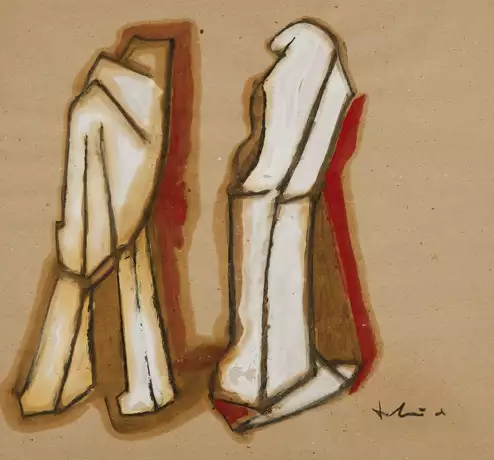
Otmar Blaser is a contemporary German artist. In 1967 he studied at the Werkkunstschule with Prof. Holweck. In 1968 he traveled through Europe, the Middle East, Canada and America. From 1970-1976 he studied at the University of the Arts in Berlin. In 1975 he was a master's student with Professor Bachmann, in 1976 he was an assistant to Professor Kapitsky at the Institute of Visual Communication and Design. In 1977 he was a lecturer at the Volkshochschule Berlin-Neukölln, collaborating freelance with the Theatertreffen Berlin.

Sobral Centeno is a Portuguese artist. He is known for his deep and complex abstract works that are characterised by an innovative use of form and texture.
Sobral Centeno's paintings are characterized by bright colours, bold and dynamic compositions, often featuring geometric shapes and patterns.

Sobral Centeno is a Portuguese artist. He is known for his deep and complex abstract works that are characterised by an innovative use of form and texture.
Sobral Centeno's paintings are characterized by bright colours, bold and dynamic compositions, often featuring geometric shapes and patterns.

Sobral Centeno is a Portuguese artist. He is known for his deep and complex abstract works that are characterised by an innovative use of form and texture.
Sobral Centeno's paintings are characterized by bright colours, bold and dynamic compositions, often featuring geometric shapes and patterns.

Sobral Centeno is a Portuguese artist. He is known for his deep and complex abstract works that are characterised by an innovative use of form and texture.
Sobral Centeno's paintings are characterized by bright colours, bold and dynamic compositions, often featuring geometric shapes and patterns.

Sobral Centeno is a Portuguese artist. He is known for his deep and complex abstract works that are characterised by an innovative use of form and texture.
Sobral Centeno's paintings are characterized by bright colours, bold and dynamic compositions, often featuring geometric shapes and patterns.

Peter Chevalier is a German painter whose paintings and drawings are close to surrealism. In the 1980s, Chevalier juxtaposed the realistic with the abstract in his paintings. Clearly configured individual but combined things (houses, airplanes, stumps of columns, light bulbs, bones, etc.) dominated, which – as if one were cutting out illustrations from magazines and reassembling them as a collage – are inconsistent in their proportions in the pictorial context.
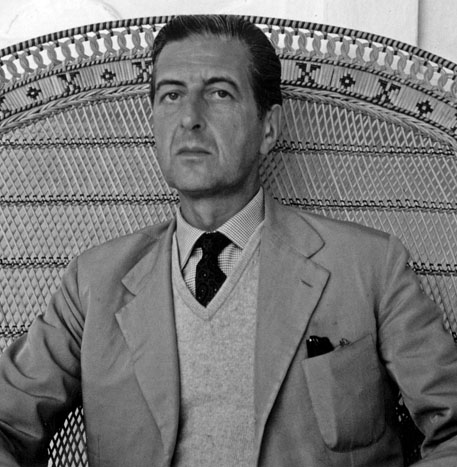
Fabrizio Clerici was an Italian painter, draftsman, illustrator, scenographer and architect.
Clerici earned a degree in architecture and was greatly influenced by antiquities, Renaissance and Baroque painting and architecture. In 1943, Clerici held his first solo exhibition at the Galleria dell'Arte Cairola in Milan, featuring drawings, watercolors, lithographs and etchings. His first book illustrations belong to the same period.
In 1947, Clerici began a prolific career in theater, ballet and opera with his debut as a stage designer in a production of George Bernard Shaw's play Mrs. Warren's Profession. The following year he participated for the first time in the Venice Biennale. There he met Salvador Dalí and created the sets and costumes for Igor Stravinsky's Orpheus, which was performed at the La Fenice Theater. In 1949 he created large-scale architectural fantasy paintings.
The further life of the multifaceted artist Fabrizio Clerici was full of work in a variety of fields of art, creative successes and exhibitions. His work has been exhibited in many museums in the United States, including MoMA and the Guggenheim Museum, as well as in France, such as the Pompidou Center.

Fabrizio Clerici was an Italian painter, draftsman, illustrator, scenographer and architect.
Clerici earned a degree in architecture and was greatly influenced by antiquities, Renaissance and Baroque painting and architecture. In 1943, Clerici held his first solo exhibition at the Galleria dell'Arte Cairola in Milan, featuring drawings, watercolors, lithographs and etchings. His first book illustrations belong to the same period.
In 1947, Clerici began a prolific career in theater, ballet and opera with his debut as a stage designer in a production of George Bernard Shaw's play Mrs. Warren's Profession. The following year he participated for the first time in the Venice Biennale. There he met Salvador Dalí and created the sets and costumes for Igor Stravinsky's Orpheus, which was performed at the La Fenice Theater. In 1949 he created large-scale architectural fantasy paintings.
The further life of the multifaceted artist Fabrizio Clerici was full of work in a variety of fields of art, creative successes and exhibitions. His work has been exhibited in many museums in the United States, including MoMA and the Guggenheim Museum, as well as in France, such as the Pompidou Center.






